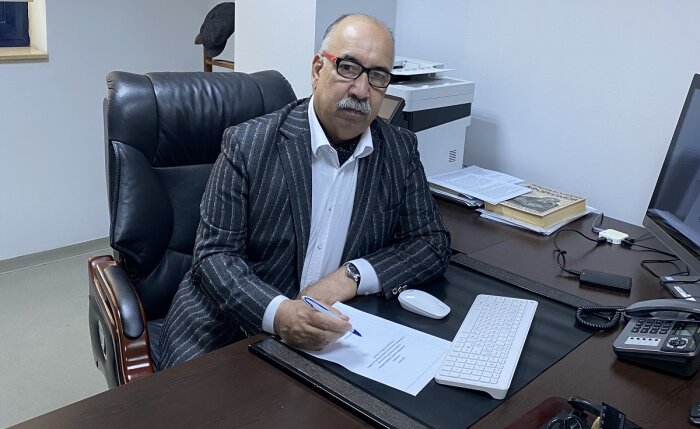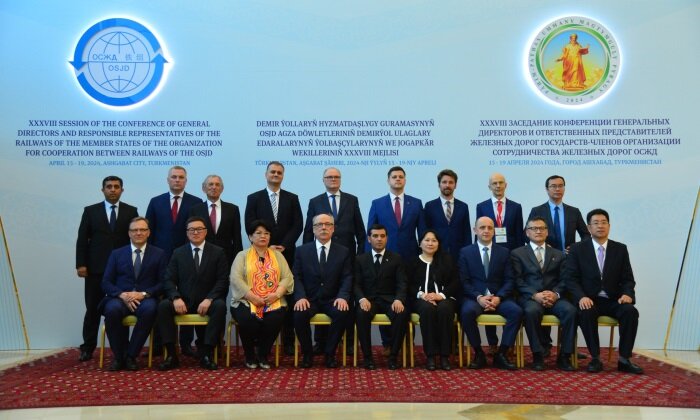 Sulphur is one of the products of Turkmenistan’s gas chemical industry, demand for which is continuously rising globally. Potential buyers of this chemical element include companies from Russia, Switzerland and Afghanistan. Doctor of Technical Sciences Allaberdy Ilyasov shared the details in an interview with CentralAsia.news.
Sulphur is one of the products of Turkmenistan’s gas chemical industry, demand for which is continuously rising globally. Potential buyers of this chemical element include companies from Russia, Switzerland and Afghanistan. Doctor of Technical Sciences Allaberdy Ilyasov shared the details in an interview with CentralAsia.news.
Field in Magdanly
Large accumulations of native sulphur are not very widespread. In Turkmenistan, a large sulphur deposit is located near Magdanly town in Lebap velayat; it was called Govurdak until 2002. The old name of the town is translated as sulphur mountain («govur» — sulphur, «dag» — mountain). By the way, a large celestine deposit was discovered in Magdanly.
In the late 20th century, the large industrial sulphur deposit was mined by either quarrying or underground smelting. A geologist A. V. Danov was the first to provide the geological description of the deposit in 1927. In 1929-35, large-scale exploration work was conducted. The formation of the deposit is associated with biochemical processes in lagoonal sediments while gypsum, anhydrite, halite, marl and limestone were deposited.
Sulphur was formed by the reduction of sulphate when anaerobic bacteria are coming into contact with hydrocarbons. This biological process led to the formation of hydrogen sulphide that was then oxidized in near-surface conditions to native sulphur, which was deposited to the bottom in the form of thin crusts and scattered inclusions.
Product in sustained demand
Sulphur is one of the important and large-tonnage chemical raw materials. It is widely used to synthesize many products (sulfuric acid, dyes, carbon disulphide, etc.) and produce a variety of substances and materials (rubber, cellulose, fertilizers, oil additives, etc.). The valuable properties of sulphur — hydrophobicity, bactericidal and binding properties, low toxicity — make it a high profit margin product on world markets.
Global sulphur demand will grow steadily over the horizon until 2036, which will be about 1 percent per year. An interesting fact is that approximately two-thirds of this increase will come from the use of sulphur, or rather sulfuric acid, to produce phosphoric acid, which is one of the main components in phosphate fertilizer production.
Business acumen
Currently, the world’s oil and gas companies sell sulphur to phosphoric acid and fertilizer producers. Given a sharp increase in demand for phosphate fertilizers and, accordingly, sulphur, it is much more profitable for an oil and gas company to sale sulphur than convert it into other products. A similar situation existed in 2015 and 2023, when global sulphur prices surged significantly. In addition to the existing segments of sulphur consumption, there are also developing large-capacity segments — building materials. These are sulphur-bitumen binder composites for asphalt concrete mixtures, asphalt concrete mixtures with sulphur-bitumen binder composites, etc.
According to the US Geological Survey, global cement production grew in 2023, and accordingly, the amplitude of bitumen consumption in road construction increased significantly. Currently, these segments can only be considered as potential competitors for construction sulphur binder, since the sales market for the latter is at an early stage of inception.
Dominance in agro-chemistry
The area of use of sulphur and sulfuric acid is agro-chemistry. 90 percent of agro-chemicals refer to crop protection chemicals — fungicides, herbicides, insecticides, etc. According to different estimates, the global crop protection chemicals market ranges from 3 to 4 million tonnes. The most commonly used sulphur-containing compound in agriculture is ammonium sulphate. This is a fertilizer that contains nitrogen and sulphur with a chemically neutral composition (24 percent sulphur and 21 percent nitrogen). Sulphur fertilizers can be applied either in an elemental form or in the form of compounds; they have a positive effect on plant metabolism. There are a number of crops that are particularly demanding of sulphur — rapeseed, buckwheat, cabbage, wheat, sugar beets, potatoes and fodder crops.
Currently, Turkmenistan produces a sufficient amount of ammonium nitrate. New effective plant nutrition technologies and new types of fertilizers need to be developed to effectively enter the agricultural market, since ammonium sulphate, although a universal fertilizer, is not without flaws. The flaws are associated with uneven fertilizer distribution and high fertilizer consumption. In this regard, tuk technology, which is considered the most promising today, can be used to produce mineral fertilizers.
Wide spectrum elements
As a rule, sulphur, regardless of the type of raw material and processing technology, as well as the general culture of production, is contaminated with harmful and ballast impurities. Non-purified sulphur is not suitable for most industries. Depending on the purpose of use, the content of various impurities is specified: bitumen — for tyre and rubber industries, selenium (absent) — for pulp and paper industry, chlorine — for sulfuric acid production, arsenic (absent) — for pharmaceutical production. However, strict environment requirements for the residual content of sulphur compounds are set for sulphur produced by the Claus process (a method for producing sulphur from gaseous hydrogen sulphide involves a thermal stage and at least one catalytic stage). The strictest purity requirements are set for sulphur used to produce cadmium sulphide, gallium sulphide and other sulphides used in the electronics industry to produce optical devices and phosphors.
The scope of usage of sulphur is very wide. It is used in medicine, fertilizers, fodder and construction. It is also used to produce film and asphalt concrete, purify water, in solvents, medications and galvanic coating. Perhaps there is no area of technical production that can do without this powdered non-metal. These are matches, tyres, paints, plastics, rubber products, pulp and paper industry, photography, sheet glass, resins, petroleum products, detergents, soap, soda, steel, batteries, textiles, synthetic fibre, metallurgy.
The processing and sale of sulphur as a raw material are among the leading investment indicators of Turkmenistan’s economy. Given huge sulphur reserves, Turkmenistan is able to become a world leader in sulphur production and processing.





